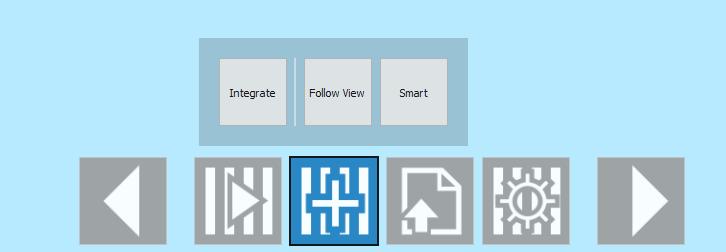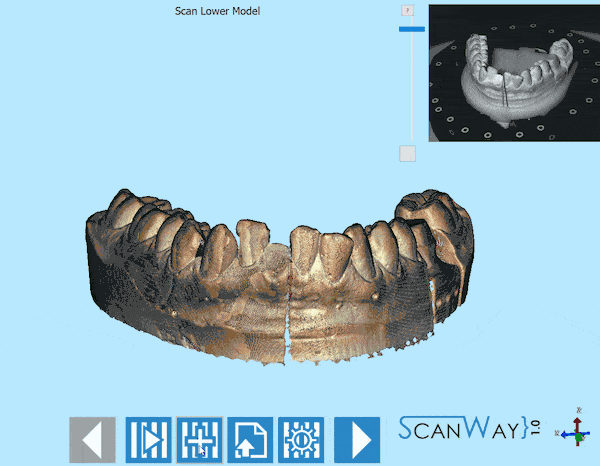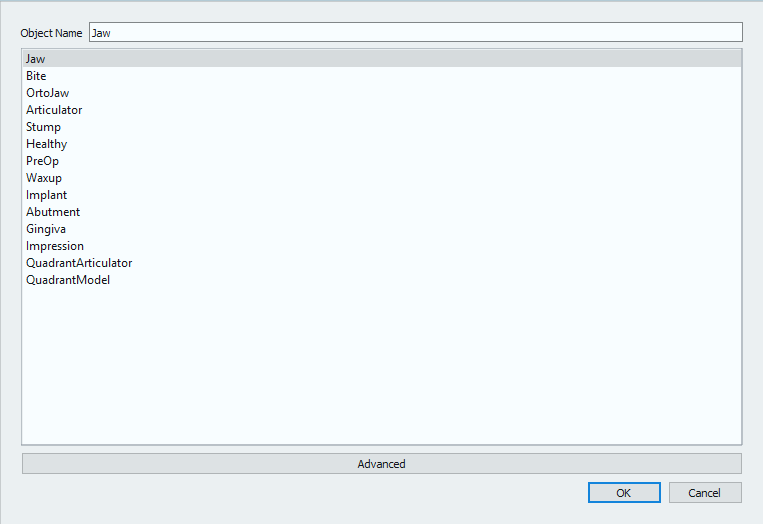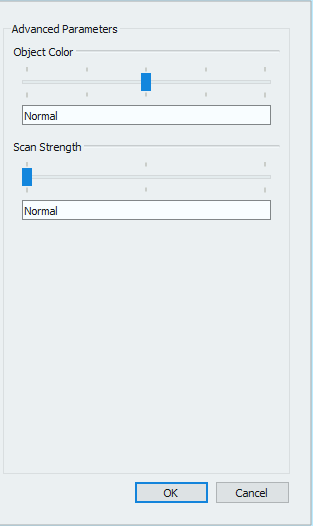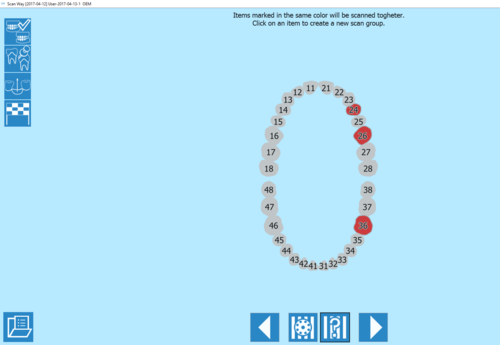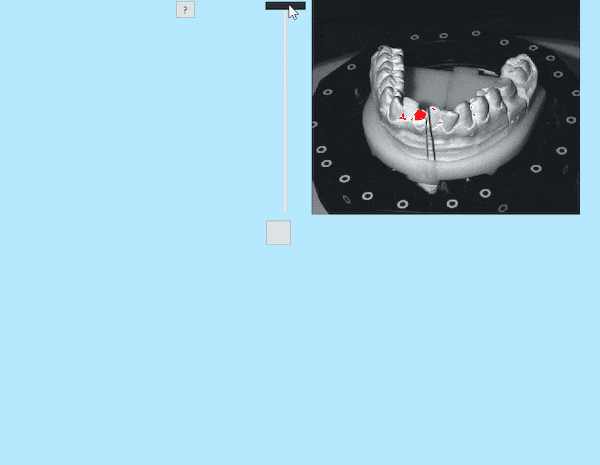Scan Interface
Contents
Structure
The scan interface is the part of the wizard that regulates the acquisition of 3D images. The main toolbar offers specific tools for scanning and the live view of the cameras on the upper right corner allows checking the position of the object in the scanning chamber and the amount of light that hits it.
Scan Toolbar
The actions in the scan toolbar may vary depending on the ongoing step. Here below a list of all the possible icons, their application, and reference step:
 Previous
Previous- Goes back to the previous step. Icon not active during the first scanning step.
 Scan
Scan- Starts the acquisition procedure specific to the ongoing step. This icon is always available.
 Integrate
Integrate- Allows to add images to the ones already acquired for the ongoing step. This icon is not available in the articulator scan step and before the scan is actually performed. This action will be better explained later on this page.
 Import
Import- Allows importing a file for the required image instead of scanning. This icon is always available.
 Advanced parameters
Advanced parameters- Allows to set a different scanning procedure for the ongoing step. This action will be better explained later on this page.
 Copy from Reference
Copy from Reference- Allows copying an image previously acquired for the ongoing step. This action is available in the healthy and pontics, and in the Waxup scanning steps. This action is fully automatic, which means the copied image is already shown in the step without having to click on the relevant icon. The user can still decide to scan the object again and then to copy the first reference if the last scan is not satisfactory.
 Next
Next- Goes one step forward in the project. This icon is available when the ongoing step is complete or in steps that can be skipped.
When the scan is launched, a progress wheel will be shown. The scan can be stopped by clicking on the ![]() button.
button.
Integration
The integration action allows adding information to the scan without having to rescan the object with the full procedure. By clicking on the ![]() button, the integration panel opens.
button, the integration panel opens.
There are two ways to carry out an integration. To choose one of the two methods click on the relevant button, to then start the integration click on the Integrate button:
- Follow View
- Click on Follow View. Move the 3D object in the space and center the view on the missing information. Check that the point that you need to scan again is visible in the live view of the cameras and click on Integrate.
- Smart
- Click on Smart. A little progress bar will appear and, when it gets to 100%, all the holes or missing information will be marked in yellow on the acquired image. Left click near the yellow lines to select an area that needs to be rescanned. The selected areas will be marked in red. Click on integrate to launch the scan sequence that will try to cover up all the selected areas of missing information.
Advanced Parameters
The Advanced Parameters button ![]() opens the profile and parameters selection dialog.
opens the profile and parameters selection dialog.
Every object is scanned with a different procedure, to get all the details of the different shapes that can be scanned and avoid to use an unnecessarily elevated number of images for a reference object. For instance, the articulation scan will be performed with only four images on a horizontal plane and reduced speed to avoid losing the balance of the occlusion; on the other hand, the models will be scanned with 6 images on a low tilt, the dies with 12 images on a higher tilt and so on.
These profiles are Open Technologies' suggestion on how to scan a determined object, but it is not said that they should be always the best procedures, seen that dental objects are seldom similar. Starting from this assumption, the user is always free to decide whether to change the scan profile or not by selecting any other voice in the profile list to increase or reduce the number of images and detail. Of course, the higher the level of detail, the higher the number of images, the heavier the resulting file.
Moreover, by clicking Advanced on the bottom of the dialog, the user will be able to change some advanced parameters of the selected scanning profile.
There are two parameters that can be modified:
- Object Color
- The shade of the specific kind of object. Like in the live view of the cameras, this parameter controls the amount of light that will hit the object; if the object is very dark it will need to be scanned with a brighter beam and vice versa.
- Scan Strength
- This parameter allows to higher the contrast of the scanning pattern to better scan difficult surfaces (translucid, metallic etc). The more the selected strength, the more time the scan will take.
Die Scan Definition
Die scanning works the same as all the other scanning steps, but it has an intermediate definition step with which the user can decide to either use the Multi die plate (default choice) or to mark a custom die scan setup.
The multi-die definition ![]() appears automatically at the beginning of the dies scanning step. The 9 positions of the multi-die will be filled starting from the elements of the first quadrant, if there are any, and follows the standard numbering order. The wizard will show in which position to insert each die. If the dies exceed the number of positions, a further step will be added to the wizard to scan all the elements defined in the project.
appears automatically at the beginning of the dies scanning step. The 9 positions of the multi-die will be filled starting from the elements of the first quadrant, if there are any, and follows the standard numbering order. The wizard will show in which position to insert each die. If the dies exceed the number of positions, a further step will be added to the wizard to scan all the elements defined in the project.
If the multi-die plate is used, the software will already know which die is in which position, and there will be no need to further identify the items that will be automatically aligned to their reference.
As an alternative to the use of the multi-die plate, the user can set a custom die scan order by clicking on the custom setup ![]() button.
button.
The software will mark all the items to be scanned in the same color which means that, by default, they would need to be scanned together. By clicking on one of the items to scan, the tooth will change color and will create a second scan group. Click then on all the items to be scanned in that second scan group. By clicking a second time on one of the already selected items, a further scan group will be created and marked in a third color. This operation can be repeated as many times as one wishes, remember that all the items marked in the same color will be scanned together.
In this mode, the software cannot know which item is scanned in which position, therefore it will require the user to identify each stump. Identification procedure will be explained in the Edit Tools page.
Marker Scan Definition
The marker (or scanbodies) scan is similar to the custom setup of the dies scan.
The software will mark all the items to be scanned in the same color which means that, by default, they would need to be scanned together. By clicking on one of the items to scan, the tooth will change color and will create a second scan group. Click then on all the items to be scanned in that second scan group. By clicking a second time on one of the already selected items, a further scan group will be created and marked in a third color. This operation can be repeated as many times as one wishes, remember that all the items marked in the same color will be scanned together.
The software cannot know which marker is scanned in which position, therefore it will require the user to identify each scanbody. Identification procedure will be explained in the Edit Tools page.
Live view
The live view of the software, on the upper right corner, allows checking the position of the object and the amount of light with which it will be scanned.
For different objects in the same project the light might need to be changed to avoid reflections and improve the scan quality.
The light intensity can be regulated using the bar on the left side of the window.
The red markings show the areas of the objects that are over-exposed and will be more problematic to acquire. Be careful not to lower too much the light intensity, as to do so, the scan quality will be worsened.
By clicking on the button below the light intensity bar, the live size changes.

